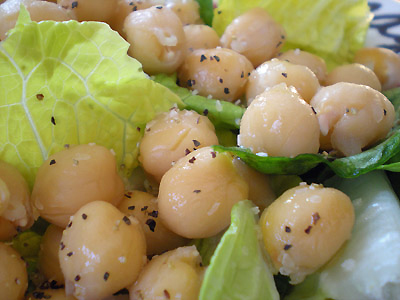
|
|
|
|
BY: SUN STAFF

Sep 23, 2010 — CANADA (SUN) — A journey through India: border to border, bhoga to prasadam. According to historians, the earliest known use of chickpeas in India dates back to 2000 B.C., in Uttar Pradesh. But as we read in yesterday's segment, Radharani was cooking besan cakes for Krsna in Vrindavan long before then.
In an ancient Kannada manuscript called the Lokopakara, written by Chavundaraya in 1025 AD., he describes a preparation called Majjige Huli, made with cumin, mustard, pepper, clove, coriander and chikpeas. This spicing combination could be used in chickpea sabji, as a spice on dry roasted chickpeas, or mixed into a chickpea paste like hummus, but the ancient dish was most likely a wet sabji.

Chickpea Salad Obviously, there is a very long history of cooking with chickpeas, and a diverse approach to using the foodstuffs. While modern scientists are just now trying to patent the method, chickpeas have long been used in beverages in India, steamed then mashed and blended into a smooth consistency, with aromatic spices and milk or yoghurt added, for a smooth delicious drink. Dried split chickpeas can be used in the same way nearly all pulses or dals are eaten. Many confections are made from them, like puran-poli (a sweet bread), mysore-pak or phutanas (puffed chickpeas).

Mysore-pak Bengali gram flour (besan) is used to make an endless number of preps -- as a batter coating, a dal or sabji thickener, or as a binder, e.g., in koftas or kabobs. Traditional breads like dhokla are made with besan, and it's often mixed in with other flours to make roti and parathas. Parched or roasted chickpeas are ground into a flour called sattu, which is a staple ingredient in Bihar and Uttar Pradesh. Sattu is usually a mixed flour, composed of 2/3 fresh roasted chickpea besan and 1/3 roasted barley flour. In Bihar, a typical mid-day meal includes fire-roasted sweet potatoes, boiled chickpeas and sattu roti. While besan works in rotis, it's not typically used for chappatis, which need to be lighter then the dense besan will accommodate.

The sattu mix of besan and barley flours forms a very nutritious foodstuff, and farmers in central India take sattu roti as a main part of their meal. Here's a nice description of a traditional sattu bread, paraphrased from a reminiscence about the foods eaten by Bengalis who were transplanted in Bihar: "…the [sattu] dough, mixed with chopped oil pickle and/or green chili, the crowning glory would be its use as a stuffing for litti. A thick wheat flour dough ball stuffed with sattu dough, roasted directly over cowdung patties may not sound like much, nor fit Western standards of haute cuisine, but I would give much to taste once more the litti made by skilled hands: the fresh ground flour, the patient kneading, the cowdung created of a diet of leaves, straw and fodder and an entire universe just vanished in the twinkling of an eye. No ghee, no nothing, just littis for dinner." Another excellent bread using sattu is made this way: in a little ghee fry some cumin along with minced ginger and green chili until they're crisped. Next add a little masala, brown sugar, and sattu. Keep stirring and fry a few minutes more, for a nice dry filling to roll into the layers of parathas or stuff into dalpuris or kachoris. Bengalis make a traditional prep from a sattu dough that's cooked and worked to a very soft consistency, almost like a liquid paste. It's eaten plain alongside rice and sabji, and even in dal, almost like a khaddi gravy. A favorite Bengali snack food is puffed rice coated in mustard oil and sattu, then tossed together with peanuts, green chilis, and black salt. Likewise, many snack foods found in India are coated very lightly in spiced besan after being fried or toasted with a little oil. For a sweet treat, whisk sattu into hot milk to get a medium-thin gruel, then add sliced bananas, brown sugar, and a little cardamom. No presentation on chickpeas would be complete without a recipe for Chana Chole – the traditional sabji of fresh cooked chickpeas in a spicy tomato base. In Hindi and Punjabi, chana is used to describe both white and black chickpeas, but actually, chana are the small green variety, while chole are the larger white variety. Whatever you call them, no Punjabi meal – whether a mid-day lunch or an opulent feast – is liable to found without a steaming bowl of Chana Chole on the table.

Chana Chole

Chickpea, Chili and Coriander Soup

Field of Chickpeas
| |